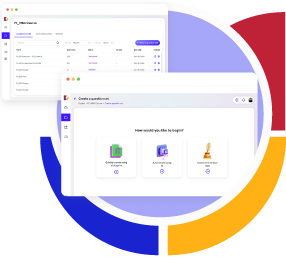
What is the Need for a Training Management System For Your Business?
Any new employee, regardless of their skill, position, or workplace, needs time to fit in. This period involves learning about the company’s policies, ethics, and workflow.
But did you know you can increase your training efficiency by up to 93%? Yes, implementing a training management system can work wonders for your company. 58% of employees prefer to learn at their own pace.
An efficient learning management system facilitates a seamless way for employees to learn and train for complex scenarios. That is why TMS as an industry is expected to reach a whopping $41 billion approx global value by 2029.
Integrating an LMS can have a great impact on your business growth. It can make learning a habit for employees while providing them with every bit of information they need without investing additional human resources.
However, businesses must completely understand training systems before using them effectively.
Table of Contents:
- What is a Training Management System?
- Features Every Training Management System Must Include
- Benefits of Using a Training Management System
- Points to Consider Before Deploying a Digital Training Management System
- In Conclusion
What is a Training Management System?
A training management system, or a learning management system, is a software app designed to provide e-training and e-learning.
In an era when 82% of employees prefer to work from home, the system can be of utmost help. It not only trains the employees but also keeps track of their progress. An LMS’s use case can be tailored to suit the company’s needs.
LMS groups worldwide use the system to sort, store, and share course materials with team members. The data on a training management system can be accessed, updated, and organized remotely.
In addition, it can help companies sustain growth, improve policy regulation, and organize processes. A TMS comes in handy, especially in large-scale organizations with niche positions and complex team dynamics. If needed, employees can use the system to share their feedback.
Also Read: Course Development to Equip a Tech-Savvy Workforce with AI Readiness
Features Every Training Management System Must Include
Before implementing a company-wide TMS, it is crucial to understand what it must include:
1. Device Compatibility
Compatibility is a vital factor to consider while using a trainee management system. Given the increasing use of smartphones, your TMS must support different OSs and devices.
2. User Experience
An easy login feature ensures that employees can quickly access the system. On the other hand, the TMS should focus on a data tracking feature for the company’s benefit.
3. Seamless Integration
The goal of integrating the digital training management system is to reduce human resources, so the TMS must remain secure and operational at every moment. Companies should ensure that their security protocols to keep the data safe must be multi-layered.
4. Centralized Training Management
A digital training management system allows all the activities of training, from scheduling to reporting, on a single platform. This means there is no scattered data; thus, tracking trainee progress and managing resources becomes streamlined.
5. Automated Scheduling and Reminders
Automation has become the trend for modern training systems that come with automatic scheduling and reminder facilities. These enable trainers and trainees to get aligned without manual follow-ups to save time and reduce the administrative workload.
Benefits of Using a Training Management System
Here are some important reasons why your business needs a training management system:
1. Consistency in Training
An LMS ensures that your employees are appropriately and equally trained. Since it facilitates a self-paced learning experience, team members consistently have a chance to grow.
At the same time, you maintain the same quality throughout the course. A trainer-led training course can be differentiated based on the instructor’s ability to engage employees. With a centralized training delivery, you can ensure that every employee gets consistent quality training via a single source.
2. Facilitates Cost Efficiency
It is safe to assume that investment in high-tech software will increase the overall business cost.
However, a digital training management system is a cost-efficient tool in the long run. TMS software allows companies to minimize the funds spent on trainers and instructors. It also eradicates the need for renting facilities and communal costs for employees to learn.
Yes, you need to program the TMS to suit your needs, but that is a one-time investment in most cases. Educating and training employees individually can burn a hole in your pocket. That is why a TMS emerges as the ideal choice to train multiple employees at the place and time of their preference.
3. Better Profits and Productivity
A study by the American Society for Training and Development has shown that companies that invest in training reap 24% higher benefits than the rest.
A learning and trainee management system facilitates the environment to achieve this. In addition, it ensures that the employees go through the training thoroughly. Quality training leads to better-educated members, who, in turn, help the company produce better results.
4. Perfecting Employee Onboarding
Want employees to retain complete awareness during the tedious onboarding process? Implementing a training management system will help you reduce the churn rate encountered by employees.
The TMS can be used to track the hiring and training process with prepared courses, assignments, and tests. At the same time, an automated onboarding process helps both the company and the employee.
5. Centralized Space for Information
A training management system becomes the hub for information that can be accessed from anywhere, at any time, using any device. This data availability can improve critical decision-making and reduce the time consumed retrieving data related to training progress, employee profiles, etc.
6. Improved Progress Tracking
With a TMS, businesses can easily keep track of the trainees’ performance and progress. They can ensure that the employees have reached their goals and have been trained properly.
Moreover, companies can use analytical tools to assess areas where the employees need betterment. If multiple trainees face issues in the same area, you can modify the lesson to make it more user-friendly.
7. Quick Course and Compliance
Your company is bound to change its operations, policies, and goals over time. A training management system can be updated in minutes to address such changes.
What’s more, is that it can be updated to meet the latest compliance and regulatory needs. Modifying the TMS and notifying employees through it is much simpler than sending everyone a copy of new policies.
Points to Consider Before Deploying a Digital Training Management System
A digital training management system can transform how your business conducts employee training. Here are the critical points to consider:
1. Business Objectives and Training Goals
Start by identifying your organization’s learning objectives. Whether it’s getting employees to learn better, inducting new employees faster, or managing certifications, ensure that the training system is aligned with one of these goals.
2. User Experience and Accessibility
A user-friendly interface is important to attract the adoption of trainees and administrators. Choose training systems that are easy to navigate and allow easy access. Finally, prefer systems that provide mobile accessibility to learn on the go.
3. Automation Features
Automation helps save time on mundane tasks like scheduling, sending notifications, and tracking progress. Automation features with more advanced functionality will save administrators’ workload and improve the effectiveness of the training process.
4. Customization Options
Each business is different, as are the needs for training in a company. A customizable trainee management system can help to customize and personalize content, workflows, and reporting to fit organizational requirements.
5. Cost vs. Value
Budget is essential, but value is what matters. Measure ROI by considering time saved, efficiency improved, and outcomes of the training enhanced. Do not choose a solution based on cost alone.
Also Read: How EqualSense Empowers Technology Leaders in Alt-Text Creation?
In Conclusion
Integrating a training management system is a necessity in today’s digital era. The system can help businesses save time, money, and resources while improving their training and onboarding efficiency.
At the same time, a TMS has better chances of satisfying employees due to its self-paced learning potential. It tracks the progress and maintains it safely in one spot for anyone to access. However, choosing the best TMS for your company can be tricky.
That is why you should opt for professionals like Hurix Digital to learn about workforce learning solutions. Doing so can simplify the process while adding a layer of expertise.
Integrate an efficient trainee management system for your organization by learning more about our services today.

 We’re live! Explore the all-new
We’re live! Explore the all-new 


